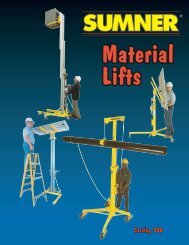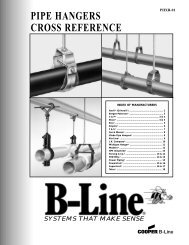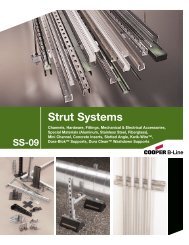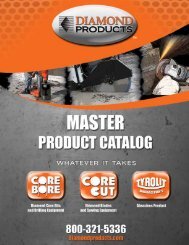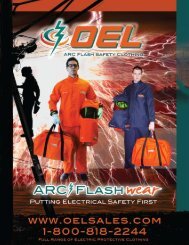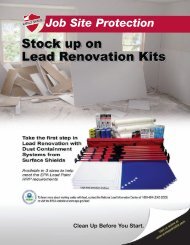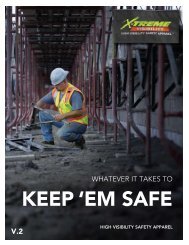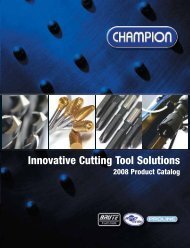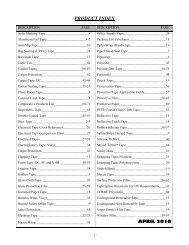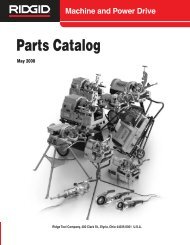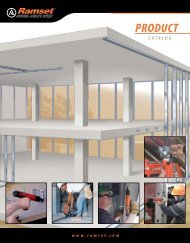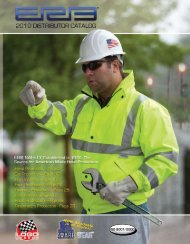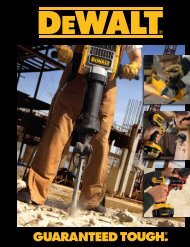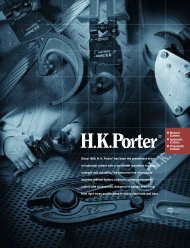Cooper B-Line Seismic Restraints - Dixie Construction Products
Cooper B-Line Seismic Restraints - Dixie Construction Products
Cooper B-Line Seismic Restraints - Dixie Construction Products
You also want an ePaper? Increase the reach of your titles
YUMPU automatically turns print PDFs into web optimized ePapers that Google loves.
STRUCTURAL ATTACHMENTS<br />
Brace Structural Attachment Selection Procedure<br />
1) Determine structure to be attached to from the following:<br />
A) Concrete<br />
B) Wood Beam<br />
C) Structural Steel<br />
2) Reference structure connection type from Appendix 1 & 2.<br />
3) Choose appropriate structural detail that meets structure connection type. (I, II, III, IV or V) pages 24<br />
thru 38.<br />
4) Determine anchor size. On concrete structure attachments, calculate minimum embedment and minimum<br />
distance between anchors.<br />
General Notes For Concrete Attachments<br />
1) The “minimum embedment” values given on pages 24 - 30 provide the anchor capacity to reach the<br />
design loads shown, but may be considered by the 1997 UBC to be “shallow” anchors (embedment less<br />
that 8 times the anchor diameter). Using “shallow” anchors may increase the design seismic forc e ,<br />
depending on the building code used. As an alternative, consider using the following values to avoid<br />
“shallow anchor” issues:<br />
Anchor Bolt Dia.“8x” Embedment<br />
3/8” 3” (76mm)<br />
1/2” 4” (101mm)<br />
5/8” 5” (127mm)<br />
3/4” 6” (152mm)<br />
2) Size and number of expansion anchors is based on "without special inspection" values given in ICBO<br />
(International Conference of Building Officials) Report No. 1385 dated September 1, 2004, Hilti Kwik<br />
Bolt 3 Carbon Steel Allowable Tension and Shear Values.<br />
3) Other anchors may be used providing they are listed in an ICBO ES Evaluation Report, which was tested<br />
in accordance with AC01, including the seismic qualification tests of AC01 Section 5.6. These values<br />
must meet or exceed the values provided in ICBO Report No. 1385, and must be approved by the<br />
structural engineer of record. OSHPD change order is required for California hospitals.<br />
4) For California Essential Facilities, 50% of the expansion type anchor (alternate anchors in a group) shall<br />
be proof tested per Appendix 3. Other projects may have similar requirements, check local codes and<br />
ordinances.<br />
5) Cast in place concrete anchors require special inspection as indicated in the building code for the local<br />
jurisdiction.<br />
6) When slab thickness is less than the minimum allowable, but in excess of the minimum anchor<br />
embedment, a thru bolt approach may be used if approved by the site engineer.<br />
7) When installing drill-in anchors in existing non-prestressed reinforced concrete, use care and caution to<br />
avoid cutting or damaging the existing re i n f o rcing bars. When installing them into existing pre s t re s s e d<br />
concrete (pre-or post-tensioned), locate the prestressed tendons by using a non-destructive method prior<br />
to installation. Exercise extreme care and caution to avoid cutting or damaging the tendons during<br />
installation. Maintain a minimum clearance of 1 inch (25mm) between the reinforcement and the drilled-in<br />
anchor.<br />
COOPER B-<strong>Line</strong><br />
509 West Monroe Street<br />
Highland, Illinois 62249<br />
Phone: 800-851-7415<br />
Fax: 618-654-1917<br />
Date:<br />
Page No.<br />
Sheet Number:<br />
6 - 2 - 06<br />
23<br />
of<br />
Raafat S. Aboulhosn<br />
Structural Engineer S 3913



